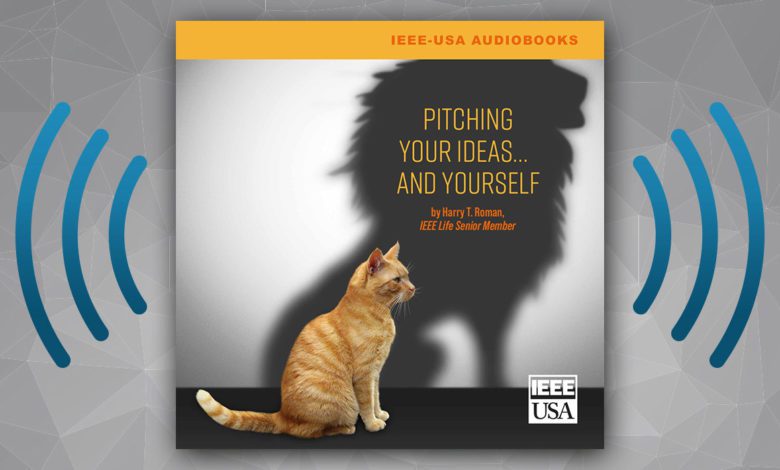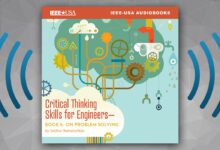
In IEEE-USA’s new audiobook, Pitching Your Ideas… and Yourself, author Harry Roman points out that we hear pitches every day — from door-to-door salesman, cold call marketers, contestants on Shark Tank, or friends trying to convince us to change a point of view or political opinion. Roman focuses on the pitch at work in this book — for a new project, for an increased budget or staff — even for a promotion.
He notes that “pitching is a special kind of public speaking. It requires bravery to stand in front of powerful people and propose something new.” Roman calls learning how to give a successful pitch “the greatest lesson I learned in the world of business,” and he says strong pitching can help one move into senior management.
In the book, Roman discusses what makes a good pitch: “Pitching is about stripping down your idea to its barest essentials; and then selling it with conviction, passion and commitment.”
He begins with a simple one — the elevator pitch. An elevator pitch is a crisp pitch you could give if you entered an elevator with an executive — and only had a floor or two to explain what you did, or what project you were working on. An elevator pitch’s goal, Roman notes, is often to obtain an agreement to listen to a longer pitch later.
The author goes on to discuss the more formal pitch with a significant ask.
Roman suggests the length of a pitch can vary, depending upon the complexity of the topic, amount and breadth of material to cover, or the audience. He recommends a pitch of no longer than 15 minutes — usually shorter. For senior executives, for example, he suggests just three to five minutes, and at most two slides — though you should be ready for a much longer discussion and Q & A, if you have successfully piqued a leader’s interest.
The author advises finding the balance between “a brutally honest presentation of the facts” and telling a story. Many engineers are hesitant to tell stories, but he points out, “Tales around the campfire are very powerful methods to convince people…even the most ardent number-crunchers love a good story.”
Other pitching advice Roman offers:
- Bring samples or prototypes — something people can hold
- Talk about you and your team — why your experience and expertise will lead the project to success
- Show confidence and enthusiasm
- Research your audience
- Practice, practice, practice (He suggests taking a video of the presentation to understand how your body language is helping or hurting.)
- Check out the room where the pitch will be held, and the audiovisual system that will be used
Roman also makes a strong case for always being ready to pitch yourself. He suggests using the S.T.A.R. method to prepare. Using this method, Roman suggests collecting the stories of your work successes, and putting them in the S.T.A.R. format.
- Situation – What is the problem you solved and the context for the problem?
- Task – What was required of you to address the problem?
- Activity – What steps did you take to solve the problem (gathering information, putting together a team, securing funding, etc.)?
- Result – What were the results? Results are the most important aspect of your story; and ultimately, what separates you from others. Be specific — include details and numbers, efficiencies gained, revenue generated, management feedback, etc.
After mastering the pitch and your pitching skills, Roman urges you to give others in your team, or those you mentor, plenty of opportunities to pitch in front of groups.
Pitching Your Ideas… and Yourself, is available free at IEEE-USA’s online shop, where you can also download the companion e-book. Visit: https://ieeeusa.org/product/pitching-your-ideas-and-yourself/
Harry T. Roman holds 12 U.S. patents. He has received numerous engineering, invention, and teaching awards and has published more than 550 scientific papers, articles and books. Roman was named a Distinguished Technology Educator by New Jersey Technology Education and Engineering Association. IEEE has honored him with a Meritorious Achievement Award for developing continuing education products for IEEE members — as well as with an Outstanding Engineer award. Throughout his engineering career, Roman has worked with schools, bringing the excitement of real-world problem solving to the classroom.







